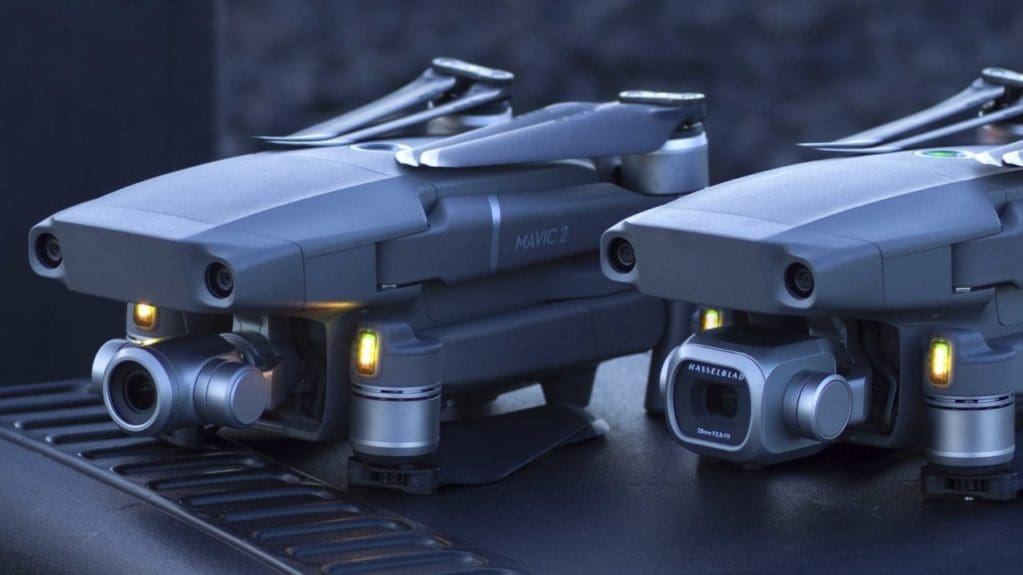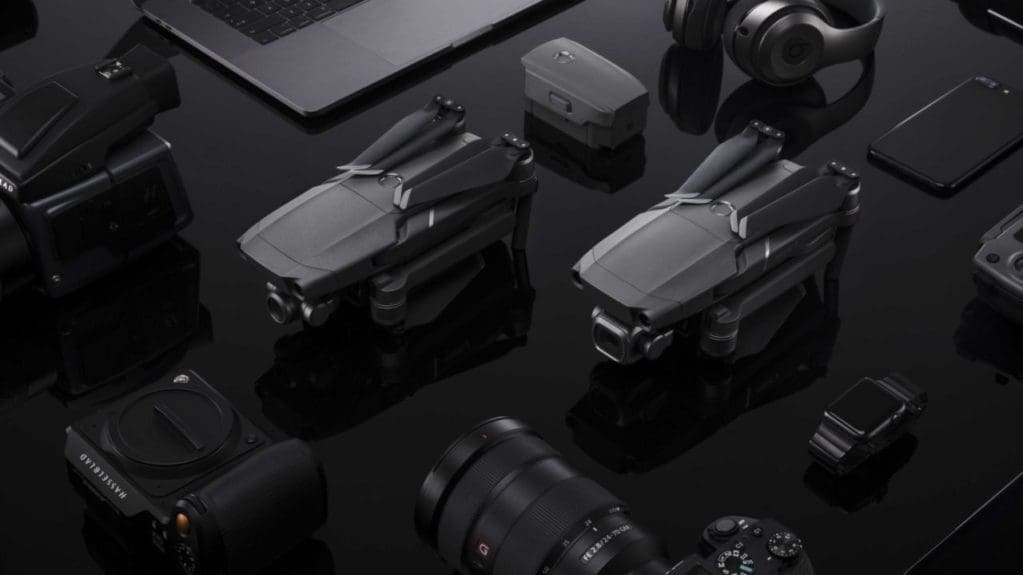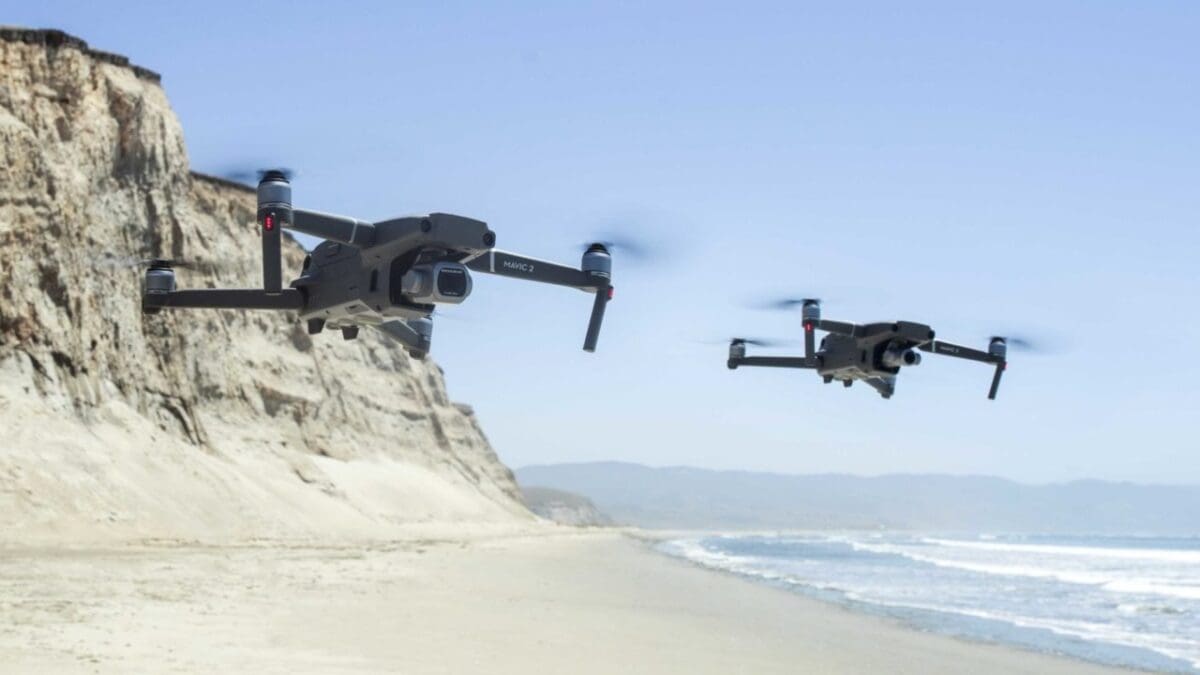Today DJI announce two new drones, well actually one drone with two different camera model options. The Mavic 2 Pro and Mavic 2 Zoom.
The two models feature identical specifications when it comes to the drone itself, but the big difference between the two is the camera. The Pro features a large sensor high-quality Hasselblad partnered model while the Zoom features a camera equipped with a zoom lens.
As well as the camera difference there’s also a slight variant in price.€1,449 /£1,299 for the Pro and €1,249/ £1,099 for the Zoom.
I’ve covered the two models separately in the following news stories.
DJI Mavic 2 Pro
DJI Mavic 2 Zoom
Here let’s take a look at the Mavic 2 drone itself.
The Mavic 2 is an evolution of the popular compact Mavic and continues to feature the same folding design and features that appealed so much with the original.
Check out the full review of the Mavic Pro here.
Two of the top hit features this time around are the new intelligent flight features and optimised flight performance, I’ll come onto these in a bit.
A new gimbal has been implemented which promises greater stabilisation than ever before and enables the inclusion of the new HDR and high-resolution photo options. There are also new intelligent features such as Hyperlapse and ActiveTrack both of which we’ll cover in depth soon.
Mavic 2 has over 30 minutes flight time
One of the biggest updates is to the life of the battery which now delivers a very respectable 31 minutes of flight for both models.
DJI has also worked on the video transmission system to enable greater stability. However, the old system seemed to work just fine, at least when you’re sticking to UK flight regs.
Roger Luo, President at DJI has said of the two drones “Today, we enter a new era of aerial photography with the introduction of DJI’s new flagship product, the Mavic 2 series. The Mavic 2 Pro and Mavic 2 Zoom will enable photographers and videographers to take their inspirations to the air quickly and elevate their creative ideas to new heights.”
Although the Pro and Zoom feature completely different cameras they do share some similarities, other than being attached to the same drone.
Both are capable of capturing 4K ultra-high definition video with a maximum recording bitrate of 100mb/s. This is impressive, and the footage is captured in the H.265 compression codec, so you’ll need to ensure your video editing software is up to date.
This code is relatively new and forms the evolution of the popular H.264 codec which has become the main standard for most online and app-based video.
As well as impressive compression rates it also gives an excellent latitude when it comes to editable data.
Photographers, as well as videographers, will benefit from the new technology in these two cameras with the new Enhanced High Dynamic Range features that enable multiple shot blending for increase dynamic range.
What does the Mavic 2 Pro offer videographers?
So why should you as a videographer get excited about the Mavic 2? Looking back the original Mavic now looks like a stepping board, testing out the market and potential before a series investment into features and video ability.

From friends that own the Mavic, I know they love the fold-down design.
The tweaks and adjustment look to bring greater flight stability and features that will bring the small Mavic 2 closer to the larger drones.
New intelligent flight features such as Hyperlapse and ActiveTrack 2.0 ensure that it is easier than ever to get the shot you want.
What is DJI Mavic 2 Hyperlapse?
Hyperlapse is essentially an intelligent airborne timelapse feature that’s operated through the DJI GO 4 App.
This enables the Mavic 2 to take a series of JPEG and RAW images simultaneously that can then be enhanced and edited to create stunning time-lapse sequences.
These time-lapses are ideal opening shots for your movies or can be equally impressive as standalone pieces.
What enhances the Hyperlapse timelapse is motion with the choice of Circle, Course Lock, Waypoint or Free mode.
What are the Mavic 2 Hyperlapse modes
- Circle – Circles the subject
- Course Lock- Flies between point A and B staying focused on the subject
- Waypoint- Complex flight path between points
- Free mode- Manually fly and capture
What is DJI Mavic 2 ActiveTrack 2.0?
Want to capture dynamic motion shots such as a car speeding through a desert, bike through a forest? Then MotionTrack is for you.
This is the 2nd release of this mode and builds on what was already a very accomplished feature.
Using the main and two front cameras the Mavic 2 is able to create a dynamic 3D map of its surroundings.
Then as it autonomously tracks it subject it will automatically avoid any obstacles that get in its way.
Auto-tracking is able to keep up with the Mavic’s increased speed of 44mph (72km/h)
Mavic 2 overhauls flight stability
Drones have featured sensors for a number of years but it was DJI who first put object avoidance into the mainstream.
That smart flight system has now been vastly updated and the latest Mavic 2. It features an incredible 10 sensors dotted around the body that will automatically detect obstacles in its path helping to avoid collisions.
A new advanced pilot assistance system (APAS) is able to analyze the surroundings using the data from those sensors.
Helping with low light flying on the base of the Mavic 2 is a bottom auxiliary light. This illuminates automatically to help with precise landings in darker conditions.
I love OcuSync 2.0
Being able to see exactly what your filming or photographing is what has made drone so popular over the years. Now the latest OcuSync increases the stability of the connection.

Featuring auto switching between both 2.4 GHz and 5.8GHz frequency bands helps to ensure less external interference. Another benefit is the ability to use different frequencies for uplink and downlink data.
OcuSync 2.0 delivers a 1080p video transmission at up to 8km distance. This enables you to instantly edit and upload Full HD footage to your platform or choice. You can also download full-resolution JPEG images without the need to download directly from the drone.
Although a cursory glance would suggest little change in design. The form has been radically redesigned to ensure a more aerodynamic airframe that reduces drag by 19%.
This enables fast maximum speeds which can now reach 44mph (72km/h) in sports mode. This increase in aerodynamics has a knock on effect enabling quiter flight and upto 31 minutes of air time.
As with the previous Mavic, there’s a three-axis gimbal that ensures stable footage. There’s also a housing that can be fitted to ensure the same stabilisation even when the drone is flying at speed.
Photo and video are stored on the 8GB of internal memory. As yet we’re unsure if the Mavic 2 will also feature a MicroSD card slot as well.
Finally, the remote sees a redesign with detachable control sticks. This makes it more portable and easy to store than ever before.
The Mavic 2 is fully compatible with the DJI Goggles. This compatibility enables gimbal Yaw control range of up to -75 / 75º in head tracking mode. This offers users an immersive FPV flight experience, but can only be used in the UK under certain controlled conditions.
Price and availability of the Mavic 2
Mavic 2 Pro and Zoom have yet to have an on-sale date but we expect that to be announced soon.
The retail package will include the drone, battery, remote controller, charger, and four pairs of propellers.
The Mavic 2 Pro’s price tag is €1,449 / £1,299 and the Mavic 2 Zoom €1,249 / £1,299.
In addition to the two main kits, there’s also a Fly More Kit. This includes two additional batteries, a multi-battery charging hub, a car charger, a battery to power bank adapter, two pairs of propellers and a carrying bag. This kit retails at €319 (£279).
A gimbal replacement service exclusively for Mavic 2, will be available soon.



